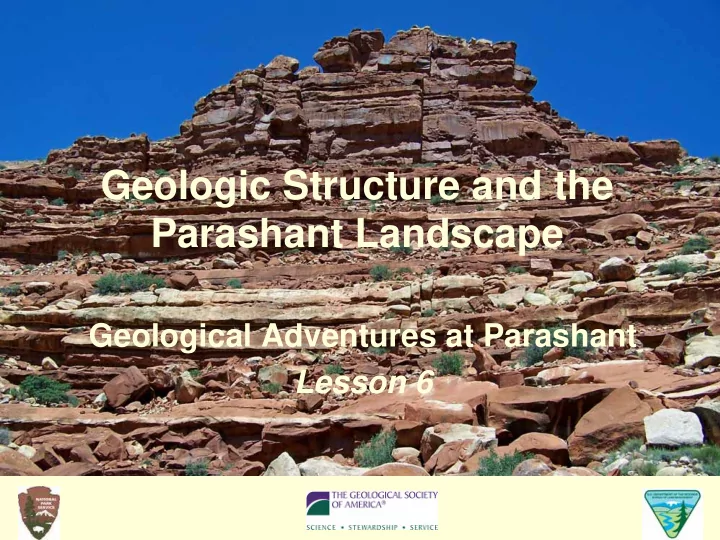

Geologic Structure and the Parashant Landscape Geological Adventures at Parashant Lesson 6
Objectives • Three basic types of stress that rocks are subjected to. • Compare and contrast brittle and ductile deformation • Folds, faults, and joints are ways that rocks respond to stress • Common types of folds and faults and the types of stress that produce each • Large-scale geologic forces have played an important role in shaping the Parashant landscape.
Materials and Set Up FIGURE1 . Materials used in Explore, Part A. The balls of clay are rounded scraps from earlier lessons. Dental floss used in the lesson is not shown.
FIGURE2 Side view of clay model with circle (made with bottle cap) and two perpendicular cross lines.
FIGURE 3 Side view of clay model after compressional stress was applied. Note that the clay is about half the original length, and that the circle is deformed, while the cross lines remain perpendicular.
FIGURE 4 Side view of clay model after tensional stress was applied. Note that the clay is about twice its original length, and that the circle is deformed. The cross lines remain perpendicular.
FIGURE 5 Top view of a clay model after shear stress was applied. Note that the circle is highly deformed. The cross lines are no longer perpendicular, but at a lower angle to one another.
FIGURE 6 Drawings showing the results of stresses applied to the models tested for this guide. Sketches are drawn to scale to each other.
FIGURE 7 . Materials used in Part B. Not shown is a wood block (or thin book) used to make the monocline.
Table 1. Results of Modeling Stress and Deformation of Rocks Structure Stress Deformation Diagram Explanation Compressional, Brittle or Ductile Label Top or Side Tensional, or View; Use arrows to Shear show directions of stress A. Anticline Compressional Ductile Forces compress rock making it bend. B. Syncline Compressional Ductile Forces compress rock making it bend. C. Monocline Tensional/Shear Ductile Forces push upward on one end of rock layers, bending them into a fold with one side.
Table 1. Results of Modeling Stress and Deformation of Rocks Structure Stress Deformation Diagram Explanation Compressional, Brittle or Ductile Label Top or Side Tensional, or View; Use arrows to Shear show directions of stress D. Normal Tensional Brittle Forces pull rocks Fault apart, causing them to break. Rocks above the break slide down the break. E. Reverse Compressional Brittle Forces push rocks Fault together until they break. Rocks above the break are pushed up the break. F. Strike-Slip Shear Brittle Rocks are broken by Fault forces that push them past each other horizontally.
FIGURE 8 . Making an anticline. Upper left: Large piece of clay cut into 3 pieces by floss. Upper right: Five pieces flattened into rectangular shapes. Lower left: Stacked layers. Lower right: Anticline fold.
FIGURE 9. Upper left: Three flat pieces of clay needed for structure. Upper right: Layers stacked with alternating colors. Lower left: Thin slice taken off side of long face to reveal layers more clearly. Lower right. Finished monocline fold.
FIGURE 10 . Upper left: Side view of the start of normal fault movement. Upper right: Side view of the completion of normal fault movement. Lower: Normal fault showing fault plane, stresses, and direction of movement along the fault. On all photos, footwall is to the right, and hanging wall to the left of fault.
FIGURE 11 . Side view of reverse fault with arrows showing direction of movement of rock units along the fault plane, and larger arrows showing the direction of compressional stress.
FIGURE 12. . Strike-slip faulting. Upper left: Top view prior to faulting. Upper right: Side view prior to faulting. Lower left: Top view after faulting showing motion along fault plane. Lower right: Side view after faulting.
Figures in Student Text
FIGURE 6.1. What do you notice about these layers of sedimentary rock near Mt. Logan at Parashant? Width shown is about 100 meters.
FIGURE 6.4. Side view of model showing fault FIGURE 6.2. Diagram of clay model with plane (heavy line). reference circle and cross-lines. model book FIGURE 6.3. Set-up of the monocline fold model. FIGURE 6.5 Top view of strike-slip fault model. Light line shows the groove. Heavy line shows the fault line.
Table 1. Results of Modeling Stress and Deformation of Rocks Structure Stress: Deformation: Diagram: Explanation Compressional, Brittle or (Label Top or tensional, or Ductile Side View; Use arrows to show shearing directions of stress) A. Anticline B. Syncline C. Monocline D. Normal Fault E. Reverse Fault F. Strike-Slip Fault
FIGURE 6.6 Rocks exposed here at Parashant are the uplifted block of a normal fault. The downthrown side on the valley floor has been buried by sediments (alluvium).
FIGURE 6.7 Nearly vertical joint in an ancient sand dune (sandstone) at Parashant.
FIGURE 6.8 Joints in this columnar basalt formed due to stress as lava cooled and contracted.
FIGURE 6.9 Fault at Parashant (fault is outlined in black). Is this a normal or reverse fault?
FIGURE 6.10 A small fold in sedimentary rocks just north of Parashant. What kind of fold is this?
Fig. 6.11 Fault in Mesozoic strata north of St. George, Utah.
FIGURE 6.12 Blocks of the Shinarump Conglomerate near Snow Canyon State Park, Utah.
Recommend
More recommend